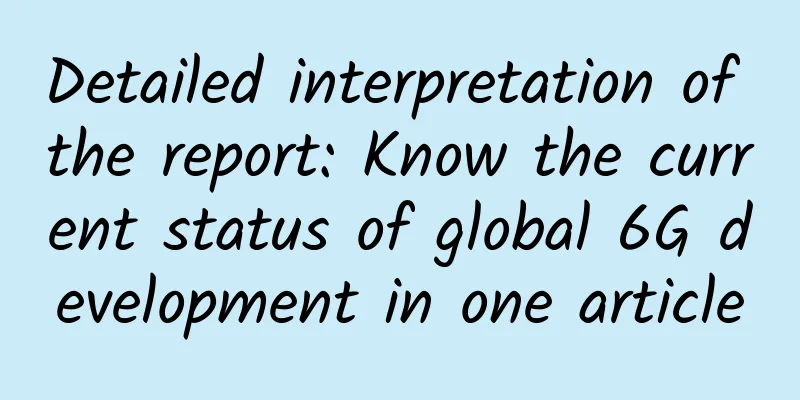Detailed interpretation of the report: Know the current status of global 6G development in one article

|
Recently, the Intellectual Property Development Research Center of the National Intellectual Property Administration held a series of theme activities for the 2021 National Intellectual Property Promotion Week and held a "6G Communication Industry Intellectual Property Research Results Promotion Conference", at which the "6G Communication Technology Patent Development Status Report" was released.
At the meeting, Wang Lei, associate researcher at the Intellectual Property Research Center of the State Intellectual Property Office, interpreted the "6G Communication Technology Patent Development Status Report" in detail from three dimensions: the significance of current 6G research, major research results, and conclusions and recommendations.
Global 6G research has been fully launchedAccording to the development law of mobile communications, a new generation of mobile communication systems will be updated approximately every ten years and adhering to the development principle of "one generation for commercial use and one generation for planning", the curtain has been raised for 6G research and development in China and even the world, and all are vying to seize the strategic 6G technology high ground. Finland, which owns Nokia, took the lead in publishing the world's first 6G white paper "Drivers and Major Research Challenges for 6G Ubiquitous Wireless Intelligence", which systematically prospected the vision and technical applications of 6G. The United States also began 6G research in 2018. The preliminary research included the research on 6G chips, and took the lead in conducting research and practice in integrated air, space, sea and land communications, especially satellite Internet communications. South Korea has listed the research and development of 6G ultra-high frequency band wireless devices as a "primary" topic. Japan already has certain advantages in the key terahertz technology of 6G. my country has also fully launched 6G research and development. In November 2019, the Ministry of Science and Technology launched the 6G technology research and development IMT-2030 promotion group, which was participated by 37 industry, academia and research institutions, and held a number of 6G seminars. The ITU and 3GPP, the standards organizations related to the communications field, have also given a timetable for the formulation of 6G-related standards. Today, the competition for 5G is very fierce. In March 2021, the Center for Strategic and International Studies (CSIS) of the United States released a report titled "Accelerating 5G in the United States," pointing out that a more comprehensive strategy toward China will be implemented in mobile communications. The report pointed out that the United States should further strengthen multilateral cooperation on the basis of current trade sanctions and export controls to force China to make concessions. The report mentioned competition and confrontation with China 75 times in the full text, pointing out that "making the world recognize that there are risks in using Chinese communication technology, and some countries have decided to ban the use of Chinese communication technology" is a major progress made by the United States, and has weakened China's international influence in "leading in 5G technology". And will continue to take the following measures to curb the development of Chinese communication technology: Strengthen transatlantic cooperation between Japan, Europe and the United States. Formulate policies to limit supply chain risks and technology transfer to reduce the flow of advanced technology into China. The adoption of the Prague Proposal has prompted the EU and transatlantic countries (Japan, Australia) to consider security issues in addition to cost when choosing communication technology facilities. The report also pays special attention to the development of 6G telecommunications technology, proposing to rely on the technology of the United States and its allies to formulate 6G standards, deploy high-value patents before the standards are formed, and grasp the advantages of standard essential patents in industrial operations. Wang Lei pointed out that patents are regarded as the most valuable products and the most powerful weapon in competition. The early stage of 6G standard construction is the key period for the deployment of standard essential patents. Owning core patents is the key to forming industrial integration and avoiding decoupling. China ranks first in 6G communication technology patentsThe report analyzes the overall patent status in the field of 6G communication technology from both global and Chinese levels. The study found that the number of global patent applications in the field of 6G communication technology exceeds 38,000, and China contributes more than 30% to the rapid growth of applications. Data shows that the total number of global patent applications in the field of 6G communication technology is more than 38,000. In the past 20 years, the number of global patent applications has generally shown an upward trend, especially after 2011, the annual number of applications for 6G communication technology-related patents has increased significantly, and the growth rate has increased significantly. China is the main source country for 6G communication technology patent applications, accounting for 35% (more than 13,000 applications), ranking first in the world. Judging from the application trends of major countries and regions in the world, patent applications in the United States, Europe and Japan have remained stable and the trend is relatively gentle. However, since 2009, the number of patent applications in China has begun to increase rapidly, significantly exceeding countries and regions such as the United States, Europe, Japan and South Korea, and has the largest contribution rate in global patent applications. Foreign companies are at the forefront of global 6G communication technology innovation, and my country's universities and research institutions are the main force of 6G innovation. Among the top ten applicants in the world in terms of patent applications, there are three in Japan, the United States and South Korea, namely Japan's NEC Corporation, South Korea's Daewoo Communications Corporation, Japan's Mitsubishi Electronics Corporation, Korea Telecom Research Institute, South Korea's Samsung Electronics, the United States Hughes Network Systems, Japan's NTT Corporation, the United States Qualcomm and the United States ViaSat. The University of Electronic Science and Technology of China ranks eighth in global patent applications. From the perspective of Chinese patent applications, domestic universities and research institutions occupy the top ten in 6G communication technology patent applications. Universities and research institutions lead the basic research and development of 6G communication technology and are the main force of 6G communication technology innovation. Analysis of the four main key technologies of 6G communicationIn the future, 6G will be driven by "intelligence" and have the technical characteristics of "fast, accurate and complete". The relevant technical characteristics also drive the emergence of key technologies. The improvement of communication performance will mainly be carried out in three aspects: spectrum resources, network architecture and air interface technology. The industry generally believes that 6G key technologies such as terahertz technology, integrated air, space, sea and land technology, deterministic network technology and AI-based air interface technology are the focus of future development. The report further analyzes the patent development status of the four key technologies of 6G communications, namely terahertz technology, integrated air, space and sea technology, deterministic network technology, and AI-based air interface technology. Terahertz technology: The total number of global patent applications involving terahertz technology is 7,737, showing an overall upward trend. China has the largest number of terahertz technology patent applications (3,118, or about 3,634), accounting for 40% of the total number of global patent applications, and the United States ranks second with 1,585. Domestic applications are the main form of Chinese patent applications, with 3,088 applications, accounting for nearly 85%, far exceeding the number of foreign applications to China (546). Among the top ten applicants in the world, six are Chinese applicants, all of which are universities and research institutions, with the University of Electronic Science and Technology of China and China University of Metrology ranking first and second. Integrated technology of air, space, sea and land: An important development direction of 6G communication is to build a global connection that integrates ground communication networks, satellite communication networks and deep-sea and ocean networks to achieve integrated air, space, sea and land. Among them, the total number of global patent applications in the field of satellite communication technology is 25,509, and the largest number of patent applications comes from China, reaching 9,159, accounting for 31%. However, there is only one Chinese company among the top ten applicants in the world, and applicants from the United States, Japan and South Korea rank among the top, among which Japan's NEC Corporation, South Korea's Daewoo Communications Corporation and Japan's Mitsubishi Electronics Corporation rank in the top three. Similarly, in the field of satellite communication technology, more than 86% of China's patent applications are domestic applications, mainly from provinces and cities such as Beijing, Guangdong and Jiangsu. Deterministic network technology: Highly reliable and low-latency deterministic network technology will mature and be widely used in the 6G era. The total number of global patent applications in the field of deterministic networks is 1,034. The United States has obvious advantages in deterministic network technology, with the largest number of patent applications (573), accounting for 55% of the total number of global patent applications. However, China's patent applications for deterministic network technology are only 232 (about 387), accounting for 23% of the total number of global patent applications. Among global patent applicants, corporate applicants dominate, with Cisco and General Electric in the United States ranking at the forefront. The development focus of deterministic network technology includes time-sensitive network technology (TSN) and large-scale deterministic network architecture technology (DIP). In terms of time-sensitive network technology, the top three patent applicants are Cisco, Siemens, and Intel. In terms of large-scale deterministic network architecture technology, Cisco, General Electric, Nokia, Ericsson and other companies rank at the top in terms of application volume. AI-based air interface technology: The future trend of 6G is to combine wireless transmission with AI deep learning at the communication physical layer. The current total number of global patent applications is 566, of which China has the largest number of patent applications, accounting for 75%. In addition, the number of Chinese patent applications has continued to grow in the past five years, and the annual number of applications has remained the highest in the world. Chinese applicants are still mainly universities and research institutes, among which Southeast University, University of Electronic Science and Technology of China, and Nanjing University of Posts and Telecommunications rank in the top three. Based on the combined development of air interface technology and AI in the future 6G network, fast and fine-grained optimization of parameters at all layers can be achieved. Relevant Chinese institutions have also conducted research on the use of AI such as adaptive waveforms, encoding and decoding, and multiple access technologies, and have carried out patent layout. Some suggestions for the development of 6G communicationsFinally, Wang Lei also introduced in detail several suggestions for the development of 6G communications mentioned in the white paper: Suggestion 1: Give full play to our own advantages and strengthen the creation and layout of independent intellectual property rights. China has an advantage in the total number of patent applications for key 6G communication technologies, and has maintained an increasing trend year by year, indicating that my country has already started technology research and development and patent layout. We should strive to use our technological advantages in 5G to continue to seize the initiative, continue to maintain a good research and development situation, and make good technology reserves and patent layout. Suggestion 2: Pay attention to foreign first-mover advantage technologies and tap into our own potential R&D strength. In key technologies such as deterministic networks, China started late, and the creation and reserve of independent intellectual property rights are relatively weak. Domestic innovation entities should pay more attention to foreign first-mover advantage technologies, tap into their own potential, and simultaneously step up technological R&D to achieve breakthroughs. At the same time, they should make full use of the intellectual property systems and policies of various countries, formulate supporting patent layout strategies while developing and setting standards, and strengthen the cultivation of high-value patents. Suggestion 3: Integrate high-quality domestic industry-university-research resources to promote the transformation of patent results. Under the current complex international environment, the domestic communications industry should be based on dual circulation, strengthen domestic industrial chain cooperation, integrate advantageous resources, try to promote effective cooperation among leading enterprises, universities and research institutes, concentrate the scientific research strength of my country's research institutes, colleges and universities and enterprises to optimize resource allocation and sharing, and promote key common technology innovation and patent results transformation and application. Recommendation 4: Promote international cooperation in the field of intellectual property rights and reduce technological dependence. Japan and South Korea have certain advantages in key technologies such as orbital angular momentum technology, satellite technology, and high-altitude platform communication for 6G communications. Japanese companies such as NTT, NEC, Mitsubishi, SoftBank, and South Korean Daewoo Communications are at the forefront of patent applications and have strong technical strength. It is recommended to carry out international cooperation in the 6G communications industry with these countries and companies to reduce dependence on European and American technologies. Recommendation 5: Combine patents and open source to create a good technical ecological environment. Taking deterministic network technology as an example, China's technology start-up and industrial application lag behind Europe and the United States, and it is still in a state of simultaneous development of industry, academia and research. Open source software (OSS) is more creative, of better quality and lower production costs. Open source has become a way for modern organizations and more and more traditional organizations to build software. It is recommended that Chinese companies combine the future core of the development of the 6G communication industry, choose the form and content of intellectual property protection, actively participate in the development of open source while strengthening patent security, and build a good ecological environment. |
>>: A quick overview of 5G industry developments in April 2021
Recommend
5G is integrated into thousands of industries, and mature commercial use still needs to achieve the following points
In recent years, 5G is undoubtedly the most popul...
China Mobile may withdraw all 3G networks by 2020, but terminals still need to support GSM
At the Global Terminal Summit held recently, Chin...
RIP is the originator of dynamic routing. Although it is not used much now, you can learn more about it when you have time.
1. Introduction to RIP RIP (Routing Information P...
TMThosting: Seattle high-security VPS monthly payment starts at $3.16, 20% off, supports Alipay
TMThosting is a foreign hosting company establish...
Mobile phone verification codes have become the scapegoat for cybercrime. Let me speak up for telecom operators!
[[347439]] It should be pointed out that this is ...
5G and the Internet of Things: Connecting Millions of Devices
As the number of connected devices continues to g...
What did the "players" in the trillion-dollar edge computing market do in the first half of 2018?
Edge computing market prospects and valuations Ed...
TMThosting Summer Promotion: 30% off monthly VPS, 35% off annual VPS, 5% off dedicated servers, Seattle data center
TMThosting has launched a 2021 Summer Sale event,...
Aruba Helps Global Operators Seamlessly Extend 5G Cellular Networks to Enterprise Environments with Passpoint-Based Wi-Fi Services
Recently, Aruba, a subsidiary of HPE, announced t...
The ultimate secret to speeding up WiFi is here!
[[434247]] Reasonable configuration of channel wi...
LOCVPS New Year Promotion: Netherlands VPS 40% off, starting from 22 yuan, Singapore VPS/Russia VPS/Hong Kong VPS 30% off
LOCVPS (Global Cloud) is a long-established Chine...
Learn Network TCP/IP Protocol Stack
[[409633]] This article is reprinted from the WeC...
MoeCloud New Year Promotion: San Jose CN2 GIA monthly payment 15% off, annual payment 30% off
MoeCloud has launched a Spring Festival promotion...
Headline: Determine whether it is an IP address
This question has a tricky part. It asks you to d...
TCP protocol status analysis, super complete~
Today I will talk to you about the state analysis...




![[11.11] Tencent Cloud 2C2G4M cloud server starts at only 50 yuan/year, 2C4G6M cloud server only 100 yuan/year](/upload/images/67cac04ca9a14.webp)




